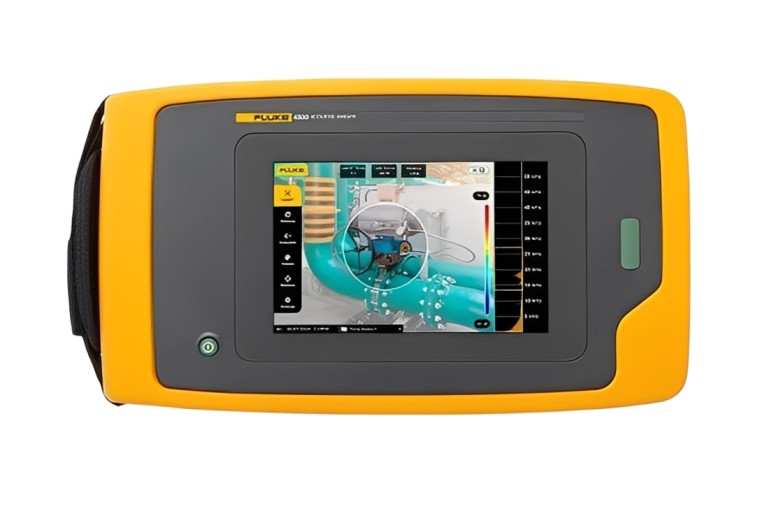
Ultrasonic Leak Detector
An ultrasonic leak detector is a handheld diagnostic tool that uses high frequency sound to find pressurised gas, air, steam, or vacuum leaks that are inaudible to the human ear. It converts ultrasonic signals into audible sounds so technicians can quickly trace the exact leak point, reduce energy waste, and improve safety in industrial environments.
What is an ultrasonic leak detector and why does it matter?
In any plant that relies on compressed air, refrigeration gases, or vacuum lines, even a small leak can waste energy, damage equipment, and create safety risks. An ultrasonic leak detector helps you detect those problems early, before they lead to downtime or costly repairs. By listening for turbulent ultrasonic noise around pipes, valves, hoses, and connectors, the instrument guides you to issues that traditional methods might miss.
Because it works purely with sound, the tool is effective in noisy facilities filled with motors, cables, contactors, and other electronics. Instead of relying only on soap solution or visual inspection, technicians can scan quickly and pinpoint leaks even around complex networks of fuses, switches, and control panels.
How does an ultrasonic leak detector work?
When a gas or air escapes through a small opening, it creates turbulence that generates ultrasonic waves. The ultrasonic leak detector uses directional sensors and sensitive microphones to pick up these high frequency signals. Internal electronics then filter out background noise and translate the ultrasonic sound into a clear tone in the headphones or speaker.
Most instruments let you adjust sensitivity so you can start at a high level to find the general area, then reduce the gain as you move closer to the leak. Some models also include LEDs or visual bar graphs so you can see signal strength while you move the probe along pipes, thermal insulation, connectors, and joints.
Sensors, electronics, and connectors inside the instrument
Inside the instrument, microcontrollers and microprocessors run controllers for gain, filters, and audio output. Quality designs use robust circuit boards, reliable capacitor choices, and carefully routed cables to keep the sensor signals clean and stable.
Key components and accessories
Modern ultrasonic leak detectors combine several components that work together as a complete test system:
- Ultrasonic sensors for airborne and structure borne sound
- Flexible probes and grips for reaching tight spaces
- Shielded cables and connectors to protect sensor signals
- Rugged housings that withstand oils, dust, and thermal cycling
- LED indicators or displays that show signal intensity and battery status
Depending on the application, you may also use thermal pads or compatible thermal cameras to confirm hot spots or refrigeration issues once a leak is found. Some kits include extra tools, spare fuses, and clip on accessories that make the instrument easier to use around crowded panels, contactors, and controllers.
Typical applications across industries
Ultrasonic leak detectors are used in many maintenance, safety, and quality assurance tasks. Common examples include:
- Locating compressed air leaks in factories, workshops, and laboratories
- Checking steam traps, valves, and thermal systems for internal leakage
- Inspecting refrigeration and HVAC systems for gas leaks
- Verifying tightness of vacuum systems in electronics and packaging lines
- Testing pipe joints, pneumatic tools, and quick release connectors
From compressed air lines to electronics production
Because the technology is non contact and non invasive, technicians can scan live systems while production continues. This makes the tool ideal for preventive maintenance programs that also use clamp meters, multimeters, and thermal cameras.
Benefits for energy efficiency and safety
Energy costs from compressed air and refrigeration systems can be significant. A single medium sized leak can waste enough electricity each year to pay for the ultrasonic leak detector several times over. By finding and repairing leaks early, facilities reduce power consumption, extend equipment life, and maintain stable system performance.
From a safety perspective, quickly identifying leaks in flammable gases, oxygen lines, or high pressure systems helps reduce risk for operators. Maintenance teams can combine ultrasonic inspections with checks on cables, insulation, and safety switches to build a practical safety strategy.

How to use an ultrasonic leak detector effectively
To get consistent results, follow a simple process every time you use the instrument:
- Inspect the area and identify pipes, hoses, valves, and connectors to test
- Turn on the ultrasonic leak detector and set an initial sensitivity level
- Scan slowly around suspected leak points while listening through headphones
- Reduce sensitivity as the sound level increases to narrow down the exact location
- Mark the leak point so repair teams can tighten fittings, replace seals, or change parts
- Record findings in a digital log on laptops or maintenance controllers for future comparison
It helps to move the probe methodically and avoid quick sweeping motions. Short, controlled movements keep the sensor close to potential leak paths, especially around flanges, threaded joints, and flexible hoses with grips and clamps.
Integrating ultrasonic leak detection into maintenance workflows
Ultrasonic leak detection is most powerful when it is part of a structured maintenance plan. Technicians can schedule inspections of compressed air lines, refrigeration systems, and vacuum circuits alongside checks on motors, contactors, and power distribution boards.
Recorded data from each inspection can be stored in maintenance software running on laptops or microcontroller based terminals. By comparing readings over time, teams can see which sections of the plant generate recurring leaks and plan targeted upgrades to connectors, hoses, and thermal insulation.
In combination with sensors, thermal pads, LEDs, and other diagnostic tools, the ultrasonic leak detector becomes a central part of a predictive maintenance strategy that protects equipment, improves safety, and reduces operating costs.

